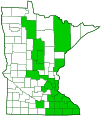May-apple
(Podophyllum peltatum)
Conservation • Wetland • Description • Habitat • Ecology • Use • Distribution • Taxonomy
Description |
||
May-apple is a 12″ to 24″ tall, erect, perennial forb that rises on a single stem from a short or elongated rhizome. The rhizome elongates in distinct, 2⅓″ to 8″ long annual increments. It produces 1 leaf or flowering stalk per year. The plant is often found in large colonies. This is a spring ephemeral, with all above-ground parts disappearing by mid-summer. The stems, when present, are erect, hairless or sparsely hairy, 12″ to 23½″ tall, and unbranched. Leaves of non-flowering plants are solitary, basal, rising from the ground on a stout, erect, stem-like leaf stalk that attaches to the lower surface of the leaf at the center of the blade. The blade is 7″ to 15″ in diameter and more or less round. Flowering plants have 2 alternate, nearly opposite leaves on 2″ to 6″ long leaf stalks rising from the top of the stem. The leaf stalks attach to the lower surface of the leaves near the margins. The blades are 2⅓″ to 14″ long, 4″ to 15¾″ wide, slightly unequal in size, and half round to kidney-shaped. Both types of leaves are deeply divided into 5 to 7, sometimes 9, lobes. The lobes are frequently divided near the tip into 2 secondary lobes, though they may have no secondary lobes. The margins may be coarsely toothed or untoothed. The upper surface is hairless. The lower surface is hairless or sparsely hairy. The inflorescence is a solitary flower at the end of the stem of flowering plants. It droops downward on a short, nodding, flower stalk that rises from the top of the stem at the angle between the two leaves. The flowers are ⅔″ to 2⅓″ in diameter. There are 6 white or pale green sepals that drop off early, and 6 to 9 white, rarely pink (fo. deamii), inversely egg-shaped petals. The number of stamens is double the number of petals. The flowers are fragrant. The fruit is a yellow, rarely orange or maroon, egg-shaped berry with 30 to 50 seeds. |
||
Height |
||
12″ to 24″ |
||
Flower Color |
||
White or pale green |
||
Similar Species |
||
Habitat |
||
Moist. Mixed deciduous forest, road banks, river banks. Partial sun. |
||
Ecology |
||
Flowering |
||
May to June |
||
Pests and Diseases |
||
|
||
Use |
||
|
||
Distribution |
||||
|
Sources |
|||
| 5/12/2023 | ||||
Nativity |
||||
Native |
||||
Occurrence |
||||
|
||||
Taxonomy |
|||
| Kingdom | Plantae (Plants) | ||
| Division | Tracheophyta (Vascular Plants) | ||
| Subdivision | Spermatophytina (Seed Plants) | ||
| Class | Magnoliopsida (Dicots) | ||
| Superorder | Ranunculanae | ||
Order |
Ranunculales (Buttercups, Poppies, and Allies) | ||
Family |
Berberidaceae (barberry) | ||
| Subfamily | Berberidoideae | ||
| Tribe | Berberideae | ||
| Subtribe | Epimediinae | ||
Genus |
Podophyllum (Mayapples) | ||
Section |
Podophyllum | ||
Subordinate Taxa |
|||
|
|||
Synonyms |
|||
|
|||
Common Names |
|||
American mandrake Indian-apple mandrake May apple May-apple Mayapple raccoon-berry wild jalap wild lemon wild mandrake wild-mandrake |
|||
Glossary
Rhizome
A horizontal, usually underground stem. It serves as a reproductive structure, producing roots below and shoots above at the nodes.
Spring ephemeral
Early blooming, short-lived wildflower that emerges in early spring and disappears by early summer. They develop above-ground parts in March or April, quickly flower and go to seed, then die back to their underground parts by May or June.
Visitor Photos |
|||||
Share your photo of this plant. |
|||||
| This button not working for you? Simply email us at info@MinnesotaSeasons.com. Attach one or more photos and, if you like, a caption. |
|||||
|
|||||
MinnesotaSeasons.com Photos |
|||||
Colony |
|||||
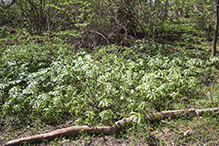 |
|||||
First week |
|||||
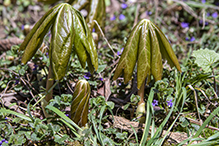 |
|||||
Plants |
|||||
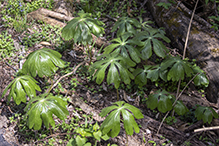 |
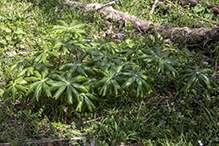 |
||||
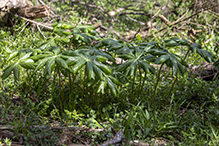 |
|||||
Flower |
|||||
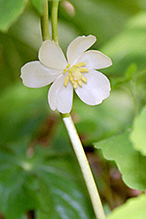 |
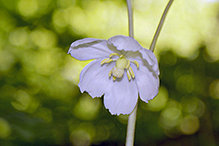 |
||||

Slideshows |
||
| Mayapple DianesDigitals |
||

|
||
About
Copyright DianesDigitals |
||
| Podophyllum peltatum Blanca Triginer |
||
About
Published on May 12, 2013 http://www.pfaf.org/user/Plant.aspx?LatinName=Podophyllum+peltatum http://www.ars-grin.gov/cgi-bin/npgs/html/taxon.pl?29138 |
||

Visitor Videos |
|||
Share your video of this plant. |
|||
| This button not working for you? Simply email us at info@MinnesotaSeasons.com. Attach a video, a YouTube link, or a cloud storage link. |
|||
Other Videos |
|||
| Mayapple [Podophyllum peltatum] BlackOwlOutdoors |
|||
About
Published on Jun 11, 2013 Krik of Black Owl Outdoors ID's the Mayapple. Known by various common names such as: hogapple, Indian apple, mayflower, umbrella plant, the Mayapple Podophyllum peltatum, is used for it's medicinal qualities. While the mayapple is not edible, doing so will result in a violent expulsion of fluids from the body, it has been proven to inhibit cell growth in the field of cancer research. |
|||
| Mayapple (Podophyllum peltatum) wvoutdoorman |
|||
About
Published on May 11, 2012 Mayapple (Podophyllum peltatum) |
|||
| Mayapple with flowers in first week of May, Podophyllum peltatum, or May Apple qhumvee |
|||
About
Published on May 10, 2013 Podophyllum peltatum, commonly called Mayapple, or May Apple Very beautiful ground cover. Poisonous though. |
|||
| Mayapple, with berries of cherry size, first week of June qhumvee |
|||
About
Published on Jun 6, 2013 Poisonous plant. |
|||

Visitor Sightings |
|||||
Report a sighting of this plant. |
|||||
| This button not working for you? Simply email us at info@MinnesotaSeasons.com. Be sure to include a location. |
|||||
| Paul Richert 10/2/2018 |
Location: 12255 205th St N, Marine on St. Croix, MN present last 3 seasons. |
||||
MinnesotaSeasons.com Sightings |
|||||

|
Created: Last Updated: © MinnesotaSeasons.com. All rights reserved. |
